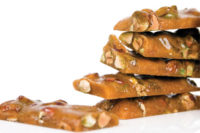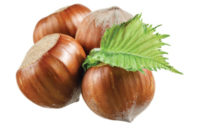Do we need to make chocolate great again? Of course not. It’s chocolate; it’s already great. It’s so great, in fact, that chocolate candy accounted for $11.2 billion—more than half—of the $21.5 billion that American consumers spent on candy in its entirety during the 52 weeks ending April 30, 2016, per Nielsen data. That makes chocolate the best-selling candy type in America.
But that doesn’t mean it couldn’t sell better. And it doesn’t mean that chocolate can afford to skate on its reputation alone—impeccable though it may be—if it hopes to keep flying off what’s become an increasingly crowded candy shelf. Although the number of new chocolate introductions is increasing, according to Innova Market Insights’ 2015 Global New Product Introductions report, there is competition with the growth of the snack category increasing at a faster rate. In North America, bars lead the snack category.
Chocolate candy is going through an evolution or a “reboot”—a freshening up that taps novel concepts, ingredients and inclusions to boost its relevance not just within a competitive category, but to a diversifying market of confectionery consumers. So as confectioners look to make chocolate even greater, some are considering using California almonds.
Trapped in its own success
Make no mistake: chocolate is in no danger of fading away. The Sterling-Rice Group’s 2014 “Global Chocolate Study” notes that consumers enjoy chocolate on about ten separate occasions per month, illustrating just how evergreen a treat it is.
But that same timeless appeal may complicate chocolate’s ability to sustain its success. As UK-based David Bradley—also known as “The Curious Confectioner”— explains, “With chocolate occupying so much of consumers’ stomach-share, chocolate confections have to work that much harder not only to maintain their position, but to keep consumers excited about coming back for more.”
Partly, that’s because the candy category now offers so many more choices for consumers to get excited about. But it’s also because today’s consumers expect more excitement from the candies they choose. “Blame the empowerment of the Internet, or the spotlight that social media shines on what we could be eating if only we had access to it,” Bradley speculates. “There has also been an increase of chocolate products as a target category where developers are producing more and more products with cleaner labels and fewer ingredients. Contemporary consumers are demanding that their confections reflect their wants, needs and values.”
Headwinds ahead
That’s a tough bill to fill, and a glance at the trend lines suggests that chocolate may be falling short. Despite growing 32 percent from $84 billion in 2009 to $111 billion in 2014, according to Euromonitor International’s July 2014 “Global Confectionery Overview,” worldwide chocolate confectionery sales face headwinds nonetheless. This comes in part from increased choices and options available in snacking.
As evidence, consider that Innova Market insights, in its “Global New Product Introductions” report of May 2016, found that global chocolate introductions increased less than global food introductions overall between 2014 and 2015. There were 22,716 overall new confectionery product introductions in 2015, down two percent from the previous year. “What that tells us,” says Harbinder Maan, senior marketing manager at the Almond Board of California, “is that going forward, chocolate products will have to ‘raise their voices’ amidst the din if the confectionery industry wants to get chocolate’s growth curve bending in the right direction.”
Almond amplification
The question for confectioners then becomes how best to amplify chocolate’s voice. A key answer lies within the same data that contains chocolate’s less sanguine projections. As Innova researchers tracked a declining share of global confectionery sales attributable to chocolate, they found that the total share of confectionery introductions involving chocolate with almonds actually grew 8 percent from 2014 to 2015, with a total of 2,364 new products introduced in 2015.
More revealing still, among all global chocolate introductions, those that specifically included almonds increased the fastest, soaring 18.2 percent during the same period. And as if that weren’t enough, Sterling-Rice found that almonds now represent 54 percent of all chocolate-with-nut occasions, and an impressive 31 percent of total chocolate occasions. “This all adds up to data-driven proof,” Maan says, “that if confectioners want to make a compelling statement with their chocolates, almonds have a persuasive body of benefits to add.”
Matters of taste—and flavor
Of course, confectioners—and consumers—could have told us that from the start. After all, anyone who’s enjoyed an almond-packed chocolate bar “gets” the appeal of the pairing. But it’s still worth examining just how harmonious a marriage chocolate and almonds can be—and why the match works as well as it does.
The reason boils down to flavor chemistry. “Chocolate is rich in ketones, pyrazines, terpenes, acetyl pyrroles and hundreds of other aromatic compounds that complement flavor compounds such as furans, tpyrazines, terpenes, pyrroles, etc. that are generated from roasting of almonds,” says Guangwei Huang, principal scientist at the Almond Board of California. “The result is a seamless melding of flavor notes that humans are practically hardwired to appreciate. Dig into the science further and it emerges just how crucially almond varietal, degree of roast, size, shape and more—not to mention the chocolate’s cacao content, bean origin, relative sweetness versus bitterness and so-on—can enhance the sensory experience.”
Flavor scientists spend their entire careers elucidating these details, but the only detail that matters to consumers is that the finished confection’s taste is great. And with 77 percent of the consumers surveyed in Sterling-Rice’s “Global Chocolate Study” pronouncing chocolate-and-almond products “tastier,” the verdict is clear. “With all their unique qualities and forms,” Maan says, “almonds
offer just the right sweet, fruity and soft-vanilla aromatics to make them a natural fit for chocolate, milk or dark.”
Hooked on a feeling: Crispy, crunchy and creamy textures
That “natural fit” isn’t solely a matter of taste, either; texture plays an important role, too. The most successful chocolate confections leverage the contrasts amongst the soft, creamy, crispy and crunchy textures that their ingredients generate. And as ingredients, almonds are uniquely positioned to offer each of the experiences.
Innova Market Insights’ 2014 “Chocolate Report” affirms that along with “smooth” and “creamy,” both “crunchy” and “crispy” topped the list of textural claims accompanying new chocolate introductions once again in 2013. No wonder 31.2 percent of chocolate-with-almond intros trumpeted their crunchiness, Innova data shows.
“Great chocolate deserves great crunch,” Huang says. “Acoustic and mechanical properties greatly influence consumer appeal, buying decisions and eventual consumption. People love the ‘bursts’ of sound associated with the friable crispness and intermittent crunchiness of almonds—be they whole, in pieces, or ground up—against the backdrop of chocolate.”
One key question with every use of almonds is what form and preparation will optimize the product. Strategically choosing the form of almond to use in a chocolate confection can help developers fine-tune textural effects, with flaked, diced, chopped and caramelized options producing a decisive crispiness, while whole, halved, slivered and diced almonds create crunch.
As Guangwei Huang, principal scientist at the Almond Board of California says, “Roasting a chosen almond form will create a crispy texture that complement well with smooth feel of chocolate while working it into a formulation will lock in its texture and maintain its crispiness for the duration of the finished chocolate’s life. A low temperature (<280F) and a longer time roasting to achieve light roasted almond forms will ensure longer lasting flavor.”
But crunchy and crispy aren’t the only games in town. Innova found that the number of “smooth” and “creamy” texture claims on chocolate-with-almond products grew from 2012 to 2013 largely on the increasing appearance of almond mousse and cream as a textural attention-getter. “Almond butter and paste also serve as handy tools for amplifying a chocolate confection’s texture,” Bradley says. “And when paired with inclusions like strawberries, cherries or coconut, their light, nutty flavor makes the finished chocolate a sensory home run for consumers.”
Almonds soften the edge of new taste experiences
The idea of using almonds as a textural tool isn’t lost on Lu Ann Williams, director of innovation at Innova Market Insights.
“Innovation in chocolate is driven by consumer interest in new combinations of textures, flavors and ingredients,” she says. And in the course of monitoring trends in the food industry more broadly, she and her colleagues have noted a number of ways in which almonds can give chocolates an advantage over competitive candies.
One such trend is what Innova calls “tastes for new experiences.” “That’s talking about flavors and textures that are bolder, more authentic or complex,” Williams explains. “They’re more sophisticated and more adventurous.”
So where do almonds fit in? As confectioners push the boundaries of the flavors and ingredients they use in their chocolate concepts, almonds can bridge the gap between “edgy” and “familiar.” Or, as Maan says, “Almonds are a touchstone. Consumers who might be nervous about trying an ‘out-there’ chocolate product feel safer when they can think, ‘Well, at least I know I’ll like the almonds.’”
Artisan confectioners are already putting the approach to use. Richard Cusick, chocolatier at Evolution Artisan Confections (Valparaiso, Ind.), appreciates how the versatility of California almonds give his creations a centered home base, whether he’s “working with acidic ingredients like aged balsamic vinegar, sweet fillings like raspberry puree or spices and chilies,” he says. “Almonds balance the flavors and are a natural complement to chocolate.”
Bradley takes “tastes for new experiences” even further, developing a Thai-Inspired Sweet and Spiced Cacao-Coated Almonds that updates the classic chocolate-coated almond with an enrobing of coconut blossom nectar and raw cacao solids infused with kaffir lime leaves, chilies and ginger.
That mouthful of sweet and spicy botanical notes proved to be “a winning combination,” Bradley says. Even as the almonds’ floral flavors complement the “exotic” lime and coconut nectar, the gentle bite of chili and ginger balance the chocolaty richness—bringing about a “lovely roundness of flavor,” according to Bradley. “They always work so well together.”
But confectioners needn’t travel to Thailand for inspiration. Even hot inclusions like sea salt and chilies, Williams notes, “offer confectioners the possibility of adding a savory touch” to chocolate-almond concepts. Globally, the use of sea salt in chocolate products with almonds grew at a 42.2 percent CAGR over the last four years, she says, representing 5.7 percent of product launches in the second half of 2015. As for chilies, chocolate launches including it are up 22 percent in the past year, leading Williams to conclude that chili “has never been more on-trend.”
An excuse to indulge
Emerging fruit flavors are also introducing an unexpected element to chocolate-and-almond confections, with the use of blueberry seeing a 19 percent CAGR from 2011 to 2015, passionfruit a 50 percent rate and coconut an eye-popping 57 percent one, Innova data show. Coconut in particular “has exploded,” Williams says, transitioning from the “waters” sector to chocolates, where its flavor compatibility makes it an obvious confectionery companion.
Williams sees it as yet another example of how all manner of fruits have “become neighbors and moved in with almonds and chocolate,” she says. And when those fruits are members of the “superfruit” family, they elevate not only the confection’s excitement quotient, but its better-for-you credibility, as well.
These days, that’s no small matter. “Health-conscious consumers are looking for permissible indulgences,” Williams says, and “chocolate’s common association with indulgence can be shifted to achieve a nutritious halo with the help of ingredients that are considered more health-forward.” Like almonds. That’s why she frequently advises customers to include “a little something healthful” when formulating indulgent concepts—a move that’s in step with another trend that she and Innova are following: “the indulgence alibi.”
Its idea is to formulate in a way that grants consumers better-for-them permission to enjoy otherwise sinful extravagances. And with one ounce of almonds supplying 4 grams of fiber, 6 grams of protein and a total polyphenol content similar to that in a half-cup of steamed broccoli or full cup of green tea, they may be a chocolate lover’s perfect alibi.
In fact, Bradley tapped almonds, chocolate and the aforementioned green tea to develop his Triple Antioxidant Almond Matcha Chocolates, which plays on the antioxidant power of the trio in a luxurious filled confection that’s indulgent alibi through-and-through.
Bradley’s muse was his daily matcha-and-almond-milk latte, which “really turned me on to that matcha-almond combination,” he says. “Who knew it was going to be so good?” It became even better when he joined the pair with coconut cream in a soft center whose “lovely” light texture he says is “perfect” for the confectionery concept.
The trick to achieving its silky smoothness was to blend whipped coconut cream with a blanched-almond paste, the texture of which is neither like an almond butter nor a marzipan, but rests comfortably in between. Further, the addition of powdered psyllium-husk fiber thickens the mix naturally while boosting the fiber content. And as for the formulation’s matcha powder, it lends both a beguiling flavor and its own nutritional benefits, the totality of which adds up to a chocolate that’s indulgent, functional and worthy of a spot on the “premium” shelf.
And indeed, almonds not only register as indulgent and functional with consumers—although they certainly register as both; when Sterling-Rice asked consumers to create their “ideal” chocolate bar, 88 percent of those who included almonds in the mix described the resulting bar as “nutritious.” But more than that, almonds consistently rank as “premium” in comparison with other nuts and amongst chocolate inclusions overall.
Seventy percent of Sterling-Rice survey respondents consider chocolate with almonds “more premium and interesting,” and 85 percent of those who included almonds in their ideal bar also stated that they’d be willing to pay more for it, which makes the choice obvious. Even a bare-bones chocolate bar is easy to love with the addition of almonds. Not only do consumers crave the combination, they will continue to look for creative pairings featuring two of their favorite ingredients together.






